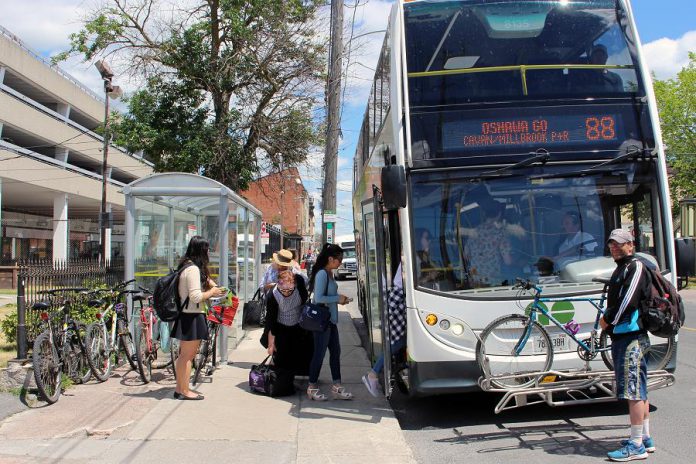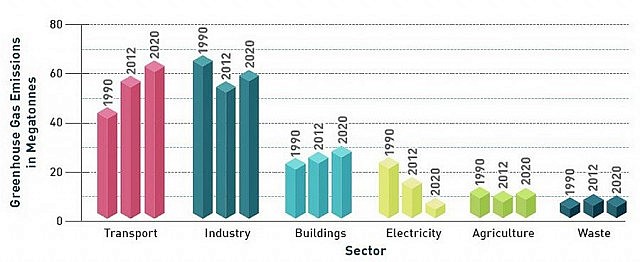
Global warming and climate change are defining issues of our time.
Recently, the Ontario government released Ontario’s Five Year Climate Change Action Plan, which details the steps the province will take to confront climate change between 2016 and 2020. The plan explains both short and long-term goals for reducing carbon emissions, and could have significant implications for our community and our environment.
Major elements in the plan include the implementation of a Cap and Trade program, proposed changes to local land-use planning policy, the introduction of a Green Bank lending program, changes to energy auditing practices, and policies and funding to support active and efficient modes of transportation.

Cap and Trade Carbon Pricing
The document begins by explaining the cap and trade program, a system the province plans to use to reduce carbon pollution.
An Ontario-wide “cap” is set that limits carbon emissions, and companies are permitted to “trade” in government-allocated credits — either to purchase more, if they exceeded their emissions cap, or to sell credits, if they managed to emit less than they were allocated.
This trade system provides economic incentive for companies to lower their carbon emissions; businesses will not want to exceed their carbon allowance because they will have to purchase more credits, experiencing financial loss. Alternatively, some businesses may work at lowering pollution emissions with the intention to sell-off their excess credits to other companies for financial gain.
Every year the cap is lowered. The goal is to reduce carbon emissions from the levels they were at in 1990 by 15% in 2020, 37% in 2030, and 80% in 2050.

Land-Use Planning
The Climate Change Action Plan also has implications for local land-use planning, including proposed amendments to Ontario’s Planning Act that could require that climate change be taken into consideration when land-planning decisions are made, and that climate change mitigation and adaptation be mandatory in municipal official plans.
In municipalities across the Province, Official Plans exist to establish key priorities and directions for future community development. The proposed changes to Official Plans in the Climate Change Action Plan could help to make climate change more central, and could help to embed other climate-focused strategy documents, such as our Community Climate Change Action Plan currently being developed by Sustainable Peterborough, within this provincial overarching framework.
In other words, the plan indicates an effort to re-design policy so that sustainable practices are built into the structure of our communities.
Home and Business Energy-Efficiency Upgrades
The document aims to incentivize environmentally sustainable decision-making and to provide citizens with the information and resources needed to give citizens choice by allowing them to work within the plan’s framework specific to their company, household, and community needs. This is the intension behind the Green Bank and the pre-sale home energy audit.
The Green Bank lending program will provide households with assistance to secure flexible, low-interest financing that will help with the cost of greenhouse gas-reducing energy improvements that people can make to their homes.
Low and moderate-income households will also be able to access additional programs to support energy-saving retrofits and decrease ongoing energy and heating costs. GreenUP already offers programs like the Enbridge Gas Distribution Home Winterproofing Program, which assists qualifying homeowners and tenants in lowering their energy bills and cutting natural gas consumption. The Peterborough Utilities Group offers similar programs for qualifying electricity companies.
Another new development is the Home Energy Rating and Disclosure program, which will require households to undergo an energy audit before being listed for sale. This requirement is scheduled to take effect in 2019, and would help prospective homeowners to better anticipate future heating and electricity use, and understand the kinds of retrofits they might be able to make in order to have a more efficient home.
Active and Efficient Transportation
Across the province and in our own community, infrastructure to support active transportation has become increasingly common, and the Plan will continue to support this kind of development. For example, the Plan proposes to establish more commuter cycling infrastructure and to invest in bicycle parking at provincially managed transit stations — for example, at GO transit stops.
The document also specifies a revision of provincial road and highway standards that will require commuter cycling infrastructure to be considered for all projects where it is safe and feasible.
If cycling and walking are not viable options for your lifestyle, there are also incentives for choosing to purchase electric vehicles over carbon-emitting vehicles.
The plan will extend the current rebate program for electric vehicle purchases — up to $14,000 when leasing or buying — until 2020, and offer up to $1000 for the installation of home-charging stations. In addition, for consumers worried about the price of their electricity bill due to charging electric vehicles, the Ontario government will offer free overnight charging for four years beginning in 2017.

These are only some of the many initiatives that the plan proposes, and while implementation could take many years, a cohesive focus on climate change is an important step forward for our province and our cities. GreenUP is committed to supporting environmentally sustainable action, at home, at work, and at school, and we are excited to see climate change action plans being developed both locally at provincially.
Climate change is complex, and identifying the opportunities to make change in your own life can feel intimidating, but we’re here to help! We offer programs to support energy efficiency at home or at your business, courses to help you feel more comfortable on your bike, and opportunities to get involved in environmental action in your community.
Visit us online at www.greenup.on.ca, or drop by our GreenUP Store and Resource Centre to find out more.


























